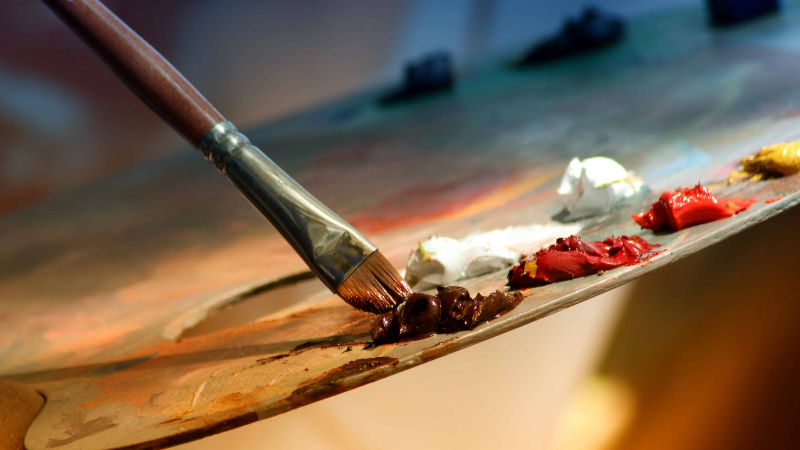What is Fine Art?
Fine Art refers to an art form that is practiced for its aesthetic value and beauty rather than its functional value. Fine Art started in drawing and design-based works such as painting, printmaking, and sculpture but has since expanded to other mediums
Fine Art is created by artists to share their artistic impressions and expressions and to allow viewers to observe, interpret and admire their works. Fine Art is rooted in drawing and design-based works such as painting, printmaking, and sculpture but contemporary Fine Art now also includes literature, poetry, music, and even dance.
Fine art is respected and critically acclaimed, whereas more commercial art might be appreciated and acknowledged, but it’s not likely to hang in Museum displays or be sought by collectors.
What 3rd level courses are available?
Universities and colleges in Ireland are offering Fine Art courses in the following subject areas:
- Fine Art – Gain the knowledge and skills needed for studio practice and intellectual and historical inquiry into Fine Art.
- Fine Art: Research – The study of Fine Art, art production, and theory.
- Fine Art with Ceramics – Gain the knowledge and skills to work autonomously and independently in a fine art context.
- Fine Art: Constructing Sculpture through Bronze Casting – An introduction to technical skills in bronze casting and sculptural construction.
- Fine Art: Printmaking – Etching & Carborundum – Develop the knowledge and skills of making prints and etching techniques.
- Fine Art: Drawing & Painting the Figure – The study of tone, light, space, composition, and pictorial structure of figures.
- Fine Art: Drawing & Painting – Techniques of Watercolour – The study of watercolor and using it to its full potential.
- Fine Art: Drawing & Painting – Drawing From Life – Develop your observational drawing skills, pacing, and handling media.
- Fine Art & Design: Visual Culture – Expand your understanding of twentieth-century art, design, and visual culture.
Studying Fine Art in college
Many full-time Fine Art courses run anywhere from 1 year to 4 years depending on the course and modules selected. There are also part-time courses and night courses available so you can be sure to fit in your studies no matter what your schedule is like.
Courses will cover all theory work through lectures, assignments, tutorials, and taught modules. Assessments will take place continuously with written examinations and practical assignments combined to achieve the qualification. You will also be expected to build and complete a portfolio for most art courses and will likely be expected to complete one major project for assessment.
Career options
After completing a course in Fine Art you will be able to get started in a career that uses specific knowledge of Fine Art and Art History.
As a graduate of Fine Art, you will likely work in Art or Design. Working hours will depend on whether you are employed by a company with set business hours or if you are self-employed. Artists and Designers generally need to be flexible to meet the needs of their clients if they are working on commissions, or you may work for yourself and can choose your hours. Inspiration may strike at any time so you will likely work in the evenings, early mornings, and weekends on occasion.
You could consider work experience or work shadowing in studios or galleries to gain real-world experience and contacts within the industry. Work Experience will not only allow you to obtain a deeper knowledge and understanding of the industry, but it will also give you a chance to do some essential networking with other professionals as well as meeting potential clients.
Related jobs include:
- Artist
- Designer
- Illustrator
- Photographer
- Fashion Designer
- Interior Designer
- Architect
- Musician
Further study
After completing a course in Fine Art you may choose to pursue further study in a specialist field to increase your knowledge base and skillset. Postgraduate study can also be used as a means to change career focus or to gain professional qualifications required to practice in certain career areas such as Interior Design or Auctioneering.
FAQ
What Are The 7 Different Forms Of Contemporary Fine Art?
- Painting utilizes pigmented colors by applying them to canvas, paper, or any other flat surface with or without a paintbrush. Oil, acrylics, watercolors, or pastels may also be used. This area of fine art includes drawing, usually with pencils, markers, paint markers, charcoal, crayons, and chalk.
- Sculpture is defined by the artists shaping, molding, and forming, shapes, and figures out of a material or various materials. The freedom of sculpture is the varied materials that can be used to do this such as stone, wire, metal, bronze, ivory, wood, plastic, clay, and other unique mediums to create structures and forms.
- Architecture is the study and the design, planning, and construction of buildings, often based on different periods such as Victorian, Gothic, Plantation, or Colonial to name a few.
- Poetry is a form of literary writing which utilizes rhythm or freeform styles in the expression of thoughts and feelings. Some forms of poetry call for specific syllables, lines, stanzas, and meter.
- Music is used to vocalize or use instruments to express feelings, thoughts, and harmony. The universal language of music underpins many world cultures and is a source of historical narrative storytelling.
- Literature is comprised of the written word and associated with a collection of written work
- Performance Dance is the use of the body for the expression of thought and emotion, with or without music. Dance is often pre-choreographed, rhythmic, sequential, and cultural. Types of dance are Ballet, Modern and Contemporary, Jazz, Ballroom, Hip-hop, Folk, and Performance Art.
Where can I study Fine Art?
Explore your options here
Did You Know?
· The Mona Lisa has her mailbox in the Louvre because of all the love letters she receives.
· Roman Statues were made with detachable heads. One head could be taken off and replaced by yet another one.
· Pablo Picasso was an animal lover. He owned a pet monkey, a goat, an owl, a turtle, and packs of dogs and cats.
· Andy Brown, an English artist, stitched together 1000 used tea bags, to create a portrait of Queen Elizabeth II.
· In 1961, Henri Matisse’s painting Le Bateau was hung upside down at New York’s Museum of Modern Art; it took 46 days before someone noticed.












Comments